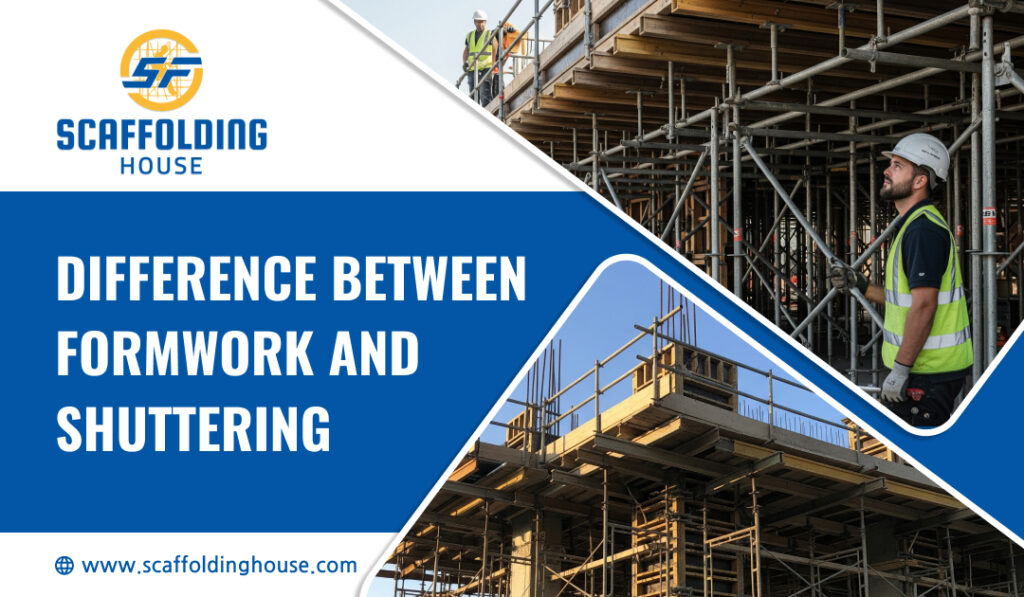Both shuttering and formwork are used to make moulds in construction work. In this process, wet concrete is poured and remains in place until it hardens. In simple terms, formwork is used in concrete construction projects, while shuttering is a method of forming moulds using plywood. Formwork and shuttering both share some similarities in construction projects.
Difference Between Shuttering And Formwork
Formwork and shuttering might seem similar concepts, but there are some differences. You might have a question: what is formwork and shuttering? We’ll answer all your questions in the blog. Now, let’s explore formwork and shuttering difference:
What is formwork?
Formwork indicates the temporary framework or mould into which wet concrete is poured and shaped until it hardens. It offers support to the poured concrete, enabling it to take the desired size and shape. Formwork is essential for achieving the required structural design and finish of concrete elements, such as columns, walls, slabs, and beams. When installing formwork, make sure to buy high-quality material.
Benefits: It provides versatility in shape and design, is reusable for various projects, and is ideal for complex structures and custom configurations.
What is shuttering?
Many people often use shuttering and formwork interchangeably, but they are different. Shuttering refers to the vertical faces of formwork, such as columns, walls, and beams, that have poured concrete. It ensures that the poured concrete maintains its shape and prevents it from deforming or spreading during the construction process. This is crucial for achieving uniform and smooth surfaces in concrete structures. Interestingly, to secure the shuttering system in place, builders often use wing nut bolts. These are essential for tightening the formwork without requiring special tools, making the process faster and more efficient.
Things to consider during formwork and shuttering
Here are a few things that you need to consider during shuttering and formwork:
- The formwork must be installed in such a way that you can dismantle it easily without damaging the concrete.
- The shuttering that comes into contact with concrete must not cause leakage of cement grout.
- The formwork levels must be inspected properly and need to be corrected as per the requirements.
- There should not be any gap in the formwork before starting concreting.
- The shuttering and centring must be designed and formed in a way that the column’s side can be removed first after the sides of the beams and the boarding under the slabs of the floor, and finally the soffit of the beams.
- Safety precautions must be taken to ensure that the joints of the formwork are made air-tight to avoid the escape of grout and air during the process of vibration. The seepage of grout and the sucking in of air could lead to honey-combing on the surface of the concrete. It can also weaken the structure.
- Generally, gaps must not exceed 1.5mm between the boards. The sections of the shutter must be made large to reduce the joints.
- Hooks, fan clamps, or other items must be given after completing the shuttering.
- To prevent the sticking of concrete, mould-releasing oil must be applied to the formwork.
How to do shuttering?
- Always use high-quality shuttering material, ensuring it has a minimum thickness of 3 inches.
- Before pouring the concrete, apply oil or grease to the shuttering to prevent the concrete from sticking and to allow easy removal.
- Make sure there are no gaps in the shuttering to avoid any leakage of the mixture.
- If working at height, use tower scaffolding to ensure safe and stable access to the shuttering.
- Wait until the concrete is fully set before removing the shuttering.
- Ideally, keep the shuttering in place for at least 16 hours, but 24 hours is recommended. When removing the shuttering, do so carefully to avoid damaging the concrete.
Conclusion
While formwork and shuttering are closely related in the process of moulding concrete structures, they serve distinct functions. Formwork is the broader term, referring to the temporary moulds that support poured concrete, allowing it to harden into the desired shape. Shuttering, on the other hand, specifically refers to the vertical face of formwork that ensures the concrete maintains its shape and structure, preventing deformation during the curing process. Moreover, if you are looking for formwork and scaffolding accessories, you can get in touch with Scaffolding House.

